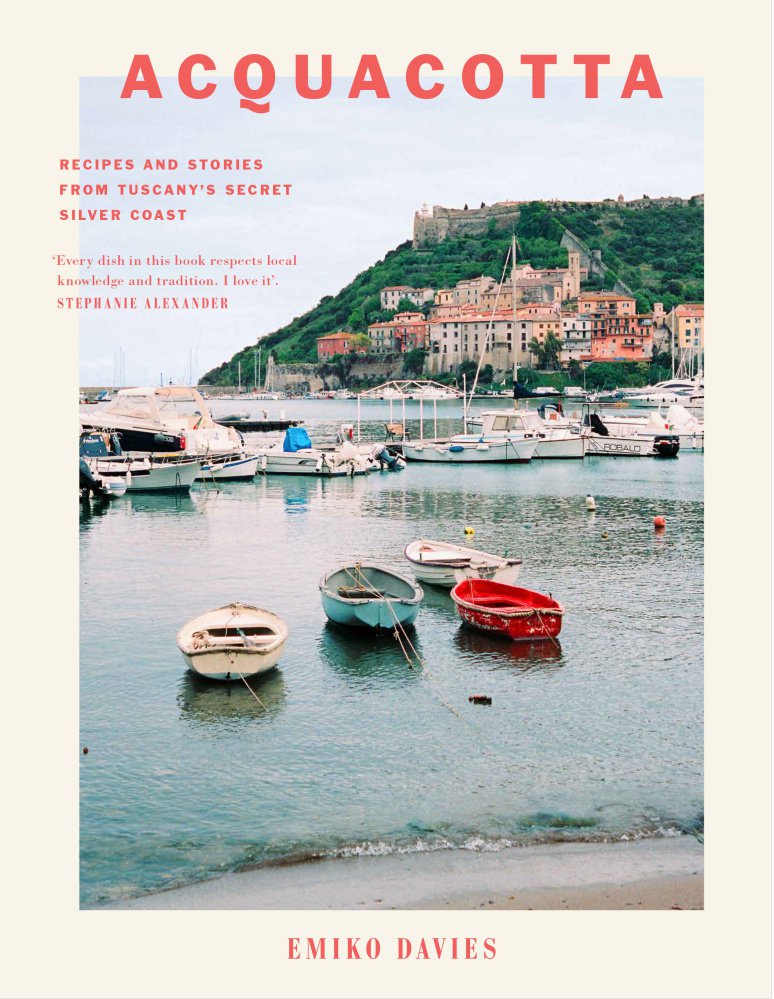“Acquacotta: Recipes and Stories from Tuscany’s Secret Silver Coast.” By Emiko Davies. Hardie Grant. $40.
“Acquacotta: Recipes and Stories from Tuscany’s Secret Silver Coast” is more like a picture storybook with some recipes than a cookbook. As writer Emiko Davies says herself, the book is “an ode to a beautiful sliver of the Maremma,” a coastal area in the southernmost part of Tuscany, along the Tyrrhenian Sea, where she lived for six months with her Tuscan husband and her daughter. Her time there made a lasting impression that inspired Davies to write about the food, the landscape, the history and the folktales of the region.
Acquacotta literally means “cooked water” and describes the basic process of the most famous dishes of the region, such as wild mushroom soup and fisherman’s acquacotta, to name just two. In English, we would call these soups or stews, but in Italian, there are specific words for the many different foods cooked in water.
The chapters are organized and named evocatively by Maremma nature themes, such as “From the Woods,” “From the Sea and Lagoon,” “From the Vegetable Patch,” and “From the Farmhouse.” The “Sweets” chapter includes recipes for items that aren’t common in American kitchens, such as Red Wine Biscuits, Fig and Chocolate Bread, Coffee-Laced Ricotta and Ansonia Grape Jam. Each chapter is abrim with beautiful photos of the natural environment where its ingredients are found, the dishes themselves, and tables of people gathering to eat the meals. In “From the Woods,” Davies writes about learning to forage for mushrooms, then gives illustrations and descriptions of six types of mushrooms from the region. She makes a point of stating that many of the dishes she includes were considered peasant food; therefore, multiple versions of the recipes exist, depending on what a farmer or cowboy (yes, there are cowboys in Tuscany!) had on hand.
For the most part, the recipes in Acquacotta are simple and use commonly found ingredients, but since I had a couple helping hands in the kitchen – my daughter Lily and our Spanish exchange student, Kattin, were looking for a project – we chose an ambitious recipe to test, Tortelli Maremmani, a ricotta and spinach tortelli (not to be confused with tortellini, tortelli are square ravioli). The recipe directions were lengthy and quite detailed, with lots of advice and alternatives interspersed with the wordy instructions. All the ingredients in the recipes in “Acquacotta” are measured in weight, so a kitchen scale is essential.

The beauty of places like Porto Ercole inspired Emiko Davies to write her cookbook about “Tuscany’s Secret Silver Coast” – the Maremma, which is in the southernmost part of Tuscany, along the Tyrrhenian Sea.
We used a rolling pin, not a pasta machine, so it took some time to roll out the dough to get it as thin as the recipe called for. The dough was very elastic and kept springing back to its thicker form. The cooked spinach required a good pressing to drain off as much water as possible. We found that the thicker the spinach-ricotta mix, the easier it is to handle and to cook inside the ravioli squares. We had filling left over to make several stuffed shells – a nice bonus, and the nutmeg added a nice note to the spinach and cheese filling.
Both the stories and photographs in “Acquacotta” are captivating. It’s a book to peruse and enjoy, as well as cook from.
– Angela King-Horne
TORTELLI MAREMMANI
Typically in Italy, pasta is just the first of several courses of a meal (called primo), not the main event (secondo).
Serves 4-6 as a main course or 8 people if it’s one of several courses
PASTA:
400 g (14 ounces) plain (all-purpose) flour, plus extra for dusting
2 whole eggs, plus 4 yolks
2 tablespoons water

Tortelli Maremmani
FILLING:
300 g (101/2 ounces) cooked spinach, about 1 kg
(2 lb 3 ounces fresh)
500 g (1 pound 2 ounces) fresh, firm ricotta, drained if needed
1 egg, beaten
50 g (13/4 ounces) finely grated Pecorino or Parmesan cheese
1/2 teaspoon freshly ground nutmeg
1/4 teaspoon salt
To make the pasta, put the flour in a bowl and make a well in the center. Pour the eggs, yolks and water in the well and use a fork to whisk the eggs, incorporating the flour little by little until you can no longer whisk with the fork. Use floured hands to combine the rest of the flour until you have a smooth, elastic dough. Wrap in plastic wrap and let rest for at least 30 minutes.
To make the filling, if you are starting with fresh spinach, trim the stalks and cook in a large pot of rapidly boiling water for about 2 minutes. Once the spinach is cooked, drain it extremely well (squeezed of all its liquid) and chop very finely.
Prepare the filling by combining the spinach with the ricotta, beaten egg, grated cheese, nutmeg and salt in a bowl.
Cut the dough into four pieces and roll out one piece at a time, rolling thin enough that you can begin to see your hand through it.
Working on strips of pasta about 14 cm (51/2 inches) wide and as long as you like, place balls of 2 teaspoons of filling onto the pasta along one long edge, roughly 2 cm (3/4 inch) from the edge and 4 cm (11/2 inches) apart. Fold the sheet of pasta lengthwise to cover the filling and line up the edges. Press pasta sheet down carefully around filling, careful not to trap air, and with a frilled-edge pastry cutter or use a knife to cut and fork to press down edges so that you have roughly a 7 x 7 cm (23/4 inch x 23/4 inch) square.
Put tortilla in a large pot of simmering water and cook until al dente, about 5 minutes.
Top with sauce and grated Pecorino cheese.
Send questions/comments to the editors.



Comments are no longer available on this story